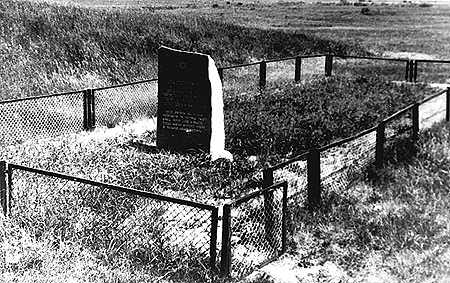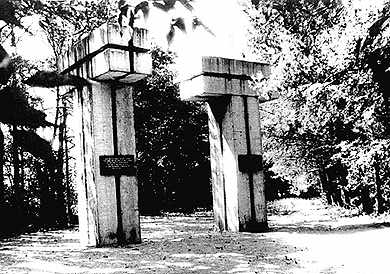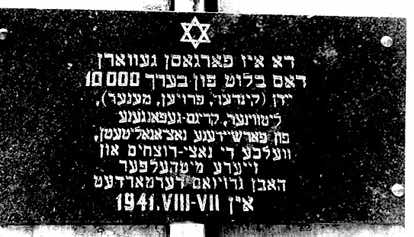H:
Postscript
1. Written by Peretz Kliatchko, a native of Kibart.
I lived in Kovno after the war and visited Kibart from time to
time. I would walk along the streets and alleys and try to imagine
the beloved pleasant town in which I had spent my happy childhood. I
would stop beside houses and backyards and try to remember the names
of the families who had lived in these houses. No Jews lived in
Kibart after the war and of those who had lived there when the war
began nobody had survived and I did not expect to meet any. I did not
even meet Lithuanian acquaintances, because the battle front ended
near Vilkavishk and the Germans evacuated the entire population from
the front zone, including Kibart, to Germany. Exhausted and battered
I would return to Kovno.
In 1960 my friend Dov Shtern, who was born in Kibart, and I went
to Kibart in order to look for the mass graves. We knew that the men
had been murdered in the sand quarries (Peskynes) and so we went
there. In nearby single houses nobody knew, or did not want to know,
the exact site of the mass graves. The answers we usually received
were that these people had been living there only since the war and
therefore had no local knowledge, but we were under the impression
that they were lying. Then we met a middle aged Lithuanian who asked
us what we were looking for, and after we told him he said that he
too was looking for the graves of the 15 Lithuanians, communists and
activists of the trade unions from Kibart and vicinity, who were
murdered together with the 185 Jewish men. He joined us and then he
asked the questions. One woman pointed in the right direction saying
that it was easy to locate the graves, because the grass on them was
much greener than in the fields nearby. We found the place easily, it
was not fenced, there were no signs, and cows were grazing in this
field. With the exception of the different shades of the color of the
grass, it looked like any other field. We stayed there, bowed down,
and departed with much pain in our hearts.
Returning to Kovno I wrote a sharp letter of protest to the local
authorities, demanding the repair of this terrible injustice. A year
later, when we, Dov Shtern and myself, visited this place again we
found it fenced off with barbed wire and in the middle there was a
wooden sign with an inscription. Cows did not graze there any more.
At the end of the 1960s I received information that a trial was to
be held in Kovno of one of the criminals who had participated in the
mass murder of Kibart's Jews. The trial was to be held in the upper
Lithuanian court, in camera. The accused was a Lithuanian, the son of
a former estate owner, who had hidden all the years until caught
recently, but I have unfortunately forgotten his name. It turned out
that another murderer, the former policeman Betinas, who had been
sentenced to 25 years in prison, had been freed. According to the
agreement between Chancellor Adenauer and Secretary Chrushchov all
German prisoners, and some Lithuanians too, who did not take an
active part in the murder of Soviet citizens, were freed from prisons
and camps. Thus, many murderers, against whom there was no legal
evidence available that they had actually shot innocent people, were
freed. The Lithuanian murderer, who had been in hiding all these
years, secretly met with that freed prisoner and concluded that he
too was exempt from punishment, but this did not happen. He was
detained, investigated, the mass graves were opened up and as a
result a charge sheet was prepared and he had to stand trial.
After great efforts I managed to get an entrance permit to the
court room. On arrival in court on the day of the trial, I met many
old women in the corridor, apparently the wives or relatives of the
15 murdered Lithuanians. As is well known, there were no Jewish
witnesses left.
Two soldiers, who took turns every hour, brought the accused into
the hall, a tall blond man in his fifties, with fluttering eyes. The
court consisted of three judges, a prosecutor and a defender. The
prosecutor was a young man with red eyes and a plaster on his nose,
apparently the result of a nightly spree. People looked at me in
surprise, since apparently my appearance caused some confusion, but
nobody asked me anything, because they understood that I had not
entered under false pretenses. The judges, the prosecutor and the
defense were all Lithuanians, only the soldiers were Russians and
they did not understand anything about the trial, because it was
conducted entirely in Lithuanian.
After the procedural part, the charge sheet was read, which said
that the accused had volunteered to join a group of Lithuanian
nationalists who detained all Jewish men in Kibartí as well as
15 Lithuanian communists, brought them to a barn near the "Peskynes"
where they were tortured for a few days, left without any food or
drink, and then were shot group by group. I remember that the
murderer was asked how it happened that a young person was found
amongst the skeletons, because only males above 16 years old were
supposed to be killed. He told the court that the 14 year old
daughter of the grocery owner Halperin arrived at the barn and did
not want to be separated from her father even after she was
threatened that she would be killed too, and so she was shot together
with all the others. A stethoscope and a pouch embossed with the
symbol of the Red Cross was found in the opened graves, "it belonged
to the medic Sher" the murderer explained. He gave the court more
details, which I have already forgotten.
The women witnesses told the court that the accused, together with
several other evildoers, appeared on one night knocking loudly on
doors and windows, and after shouting "where are the Bolsheviks?"
forced the men to dress quickly, not allowing them to take anything
with them. They were seated in carts and taken to the barn, where
during the few days that they were kept there, the women were not
allowed to approach or to bring them any food. One day a lot of shots
were heard from there, during which all the approaches to this place
were blocked, and when the women arrived on the next day they found
an empty barn and covered graves. They also heard that the clothes of
the victims, which they had been forced to remove before being shot,
were divided up among the murderers.
The accused claimed that he did not detain people and did not
shoot, but that he, armed with a rifle, only transported them in
groups to the holes. But the witnesses insisted that he arrested
their husbands and one of them even said that his voice still rang in
her ears and would never stop. The accused, when replying to the
witness, maintained that his voice had changed during the years and
she, as a devoted catholic, would surely have to give account of her
testimony before a heavenly court and should therefore rethink her
testimony. The woman crossed herself trembling and declared fearfully
that maybe she was mistaken.
The prosecutor demanded maximum punishment, whereas the defense
asked for an acquittal, because the accused had already suffered
enough by hiding all these years, there being no proof that he
himself had shot people and there was an amnesty for collaboration
with the Germans. The speeches of the prosecution and the defense
were monotonous as if this were a routine case, instead of being the
trial of a murderer of 200 innocent people.
The trial ended with the verdict that the accused was guilty of
murder, but taking into consideration that there was no proof that he
himself had shot people and that there were no witnesses to this
effect, he was sentenced to seven years in prison.
I looked at the murderer's face when sentence was pronounced and
saw fear in his eyes on the verdict of guilty of murder, but when he
heard the punishment was only seven years in prison his face lit up
and he was satisfied. The sentence was final, with no possibility of
appeal.
I left the hall confused and hurt, and for several days I could
not find peace of mind nor was I able to sleep. Once again I was
overcome by all the tragedy of Kibart and could not free myself from
these feelings for a long time.
2. Written by David Shadchanovitz, a native of Kibart.
In June 1965, after returning from exile in Russia, I visited
Kibart and Virbalis. I wanted to visit the graves of Kibart's martyrs
who were murdered by the Nazis and their Lithuanian helpers. With
great emotion and a trembling heart I went out in the direction of
the Peskynes, where the first 200 victims were murdered. On my way
there I tried to ascertain from local inhabitants where the exact
place was, but all of them evaded answering, saying that they had
been living there only for a short while. A Lithuanian woman from
whom I bought flowers, agreed to point out the place of the murder. I
found the place in accordance with her description, which was about
2.0-2.5 kilometers eastwards from the railway station along a dust
road. I found the graves surrounded by a wooden fence and a sign
written in Lithuanian: "Passerby, stop and bow your head for the
victims of fascist terror. In this place 200 Soviet citizens are
buried, who were shot by German fascists."I placed the flowers there,
and with a bowed head said "Kadish."
I returned to Kibart and from there I went to Virbalis in order to
visit the graves of the remainder of the Kibart and Virbalis Jews. I
knew that these were in the Vygainis, a field about 1.5 kilometers
from the town. I remembered this place still from the time of my
studies in the Hebrew High School in Virbalis when we went to play
soccer and other games. I saw 12 holes /graves, but no fence and no
sign could be seen, with cows and horses grazing on the graves. I
cried bitterly seeing this terrible sight and recorded it in a photo.
I was shocked because of the inhuman attitude of the local
authorities who did not care about minimum conditions for remembering
the victims. I made my way to the Virbalis local council which was
situated in a former Jewish house in the main street, where the only
clerk there, a girl, informed me that this issue of commemoration was
under the authority of the town mayor, who resided in Kibart. I
returned to Kibart, found the office of the mayor and put my case to
a clerk, since the mayor himself was not present. He told me that
they were aware of the situation, that a monument would be set up
soon, and that the area of the graves would be fenced off. Returning
to Vilna with a broken heart I sent a letter to the town mayor in
Kibart on the same issue, and after some time I received an answer
assuring me that a decision had been made to set up a monument that
year (1966) and to erect a fence around this place. Three years
passed, during which I did not visit the graves again. A week before
our Aliya to Israel (1969), together with my wife and my two
daughters, I visited the graves at the "Vygainis" in Virbalis. I
brought my young daughters there in order to show them what the Nazi
murderers had done to our nation and to our family.

Mass Graves in Kibart
Inscriptions in Yiddish and Lithuanian (free translation):
"In this place the Jews of Kibart and a group of Lithuanians
were murdered by the Nazis and their local helpers."
Among the victims were the Author's Father and two Cousins.

Mass Graves near Virbalis

Inscription at the Mass Graves near Virbalis
The inscriptions in Lithuanian and Yiddish on the tables
says:
"Here was spilled the blood of about 10,000 Jews (Men, Women
and Children), Lithuanians, War Prisoners
of different nationalities,
who were cruelly murdered by the Nazi murderers and their helpers in
July and August 1941."
Among the victims there were the author's Mother, Sister, Aunt
and Cousin.
The monument at the mass graves near Virbalis was established in
1991.
On that visit we found the place fenced off with a chain and there
stood a concrete monument more than two meters high. The inscriptions
on it, in Lithuanian and Russian, said that in this place Soviet
citizens were murdered in 1941 by the Nazi fascists. There was no
mention of the fact that at least some of those Soviet citizens were
Jews and that their only crime was their Judaism. I found an empty
barrel nearby onto which I climbed, and with my small pocketknife I
engraved a Magen-David on all four sides of the top of the monument.
I heard later from friends who visited the place that those
Maginei-David could still be seen and were not blurred. I suppose
that no one visits this place anymore, and therefore there is no one
who could rub out my engraving.
During those two visits to Kibart I was curious to see how the
town, where I had spent a happy childhood, would look after the 23
and 27 years that I had not been there and what changes the events of
the war had made. I did not expect to meet acquaintances, not
Lithuanians and surely no Jews. I only wanted to see the streets and
the buildings, each of them a reminder of something my past.
I arrived in Kibart by bus from Virbalis. The entrance to the town
along the main street had not changed much. The "Torklerina" stood as
before, with a few small changes and the sawmill, which once belonged
to Shemesh, continues to work as before. Opposite there stood the
former German school and I had no idea which institution was using
the building now. Vishtinetz (Vistytis) street was partly ruined and
the small houses looked as though they had sunk into the earth. From
there on, in the direction of the border, the ruins started. The
whole quarter, beginning from our house (Shadchanovitz), Miltz,
Budrevitz, the shops of Rosin and Katzizne and further along in the
street of the synagogue the house of Pliskin, the synagogue itself,
the house of Weitz, the bathhouse, were all destroyed, with cattle
grazing where the buildings had formally been located.
In 1969, on my last visit to Kibart, I noticed that on the plot
where our house had stood, a large building, designed to be a
restaurant, was under construction.
The red brick houses of the railway workers were intact, without
any damage, as was the building of the fire brigade, and also the
Pravoslav and Catholic churches, which stood there as before.
The grandiose railway station had been razed to the ground, there
was nothing left, and in its place a small building had been erected,
for selling tickets. The station sign read "Kybartai," not "Virbalis"
as it had for the last 100 years. The"Railway Garden" was ruined too
and only some remnants of the bowling alley and a pile of stones
where the raised balcony for the orchestra used to be, reminded one
of past beauty.
The public park in the main street was not damaged. The houses of
the local police and the government bank were ruined, but new similar
buildings were being built. Seinensky's house and other buildings
towards the border were not damaged, except for some small buildings
in the yards which had been burnt. The long Torkler house near the
border was undamaged, Lithuanian families lived in the former Jewish
shops and in the former customís building near the border. The
wooden bridge over the Liepona stream had apparently been burnt down
and a new concrete bridge had been built in its place. Eydtkuhnen was
totally destroyed except for the railway station and a few buildings
where the shops of Rubinshtein and Zilberman used to be. There was no
civilian population in Eydtkuhnen and those few existing houses were
defined as a military zone.
To tell the truth I felt some satisfaction that our house and
those of the neighbors had been destroyed, but I also felt sorry that
many Jewish houses still stood intact, their owners and their tenants
having been buried in mass graves, with Lithuanians living in them
instead.
This material is made available by JewishGen, Inc.
and the Yizkor Book Project for the purpose of
fulfilling our
mission of disseminating information about the Holocaust and
destroyed Jewish communities.
This material may not be copied,
sold or bartered without JewishGen, Inc.'s permission. Rights may be
reserved by the copyright holder.
JewishGen, Inc. makes no representations regarding the accuracy of
the translation. The reader may wish to refer to the original material
for verification.
JewishGen is not responsible for inaccuracies or omissions in the original work and cannot rewrite or edit the text to correct inaccuracies and/or omissions.
Our mission is to produce a translation of the original work and we cannot verify the accuracy of statements or alter facts cited.
 Kibart (Kybartai), Lithuania
Kibart (Kybartai), Lithuania
 Yizkor Book Project
Yizkor Book Project
 JewishGen Home Page
JewishGen Home Page
Yizkor Book Director, Lance Ackerfeld
This web page created by Joel Alpert
Copyright © 1999-2026 by JewishGen, Inc.
Updated 13 Mar 2003 by LA





